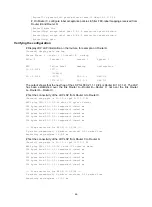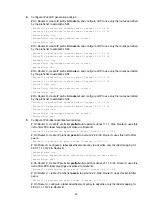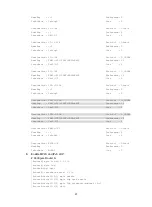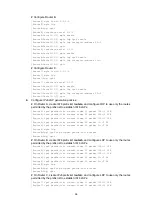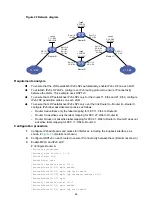
52
LDP FRR configuration example
Network requirements
Router S, Router A, and Router D reside in the same OSPF domain. Configure OSPF FRR so LDP
can establish a primary LSP and a backup LSP on the Router S—Router D and the Router
S—Router A—Router D links, respectively.
When the primary LSP operates correctly, traffic between subnets 11.1.1.0/24 and 21.1.1.0/24 is
forwarded through the LSP.
When the primary LSP fails, traffic between the two subnets can be immediately switched to the
backup LSP.
Figure 21 Network diagram
Requirements analysis
•
To ensure that the LSRs establish IPv4 LSPs automatically, enable IPv4 LDP on each LSR.
•
To establish IPv4 LDP LSPs, configure an IPv4 routing protocol to ensure IP connectivity
between the LSRs. This example uses OSPF.
•
To ensure that LDP establishes IPv4 LSPs only for the routes 11.1.1.0/24 and 21.1.1.0/24,
configure IPv4 LSP generation policies on each LSR.
•
To allow LDP to establish backup LSRs, configure OSPF FRR on Router S and Router D.
Configuration procedure
1.
Configure IP addresses and masks for interfaces, including the loopback interfaces, as shown
in
. (Details not shown.)
2.
Configure OSPF on each router to ensure IP connectivity between them. (Details not shown.)
3.
Configure OSPF FRR by using one of the following methods:
{
(Method 1.) Enable OSPF FRR to calculate a backup next hop by using the LFA algorithm:
# Configure Router S.
<RouterS> system-view
[RouterS] bfd echo-source-ip 10.10.10.10
[RouterS] ospf 1
[RouterS-ospf-1] fast-reroute lfa
[RouterS-ospf-1] quit
# Configure Router D.
<RouterD> system-view
Loop0
1.1.1.1/32
Router A
Router S
Router D
GE
1/1
/1
12
.12
.12
.1/
24
GE1/1/2
13.13.13.1/24
GE1/1/2
13.13.13.2/24
GE
1/1
/1
12
.12
.12
.2/
24
GE
1/1
/2
24.2
4.2
4.2
/24
GE
1/1
/1
24.2
4.2
4.4
/24
Loop0
3.3.3.3/32
Primary LSP
Backup LSP
Loop0
2.2.2.2/32
11.1.1.0/24
21.1.1.0/24









